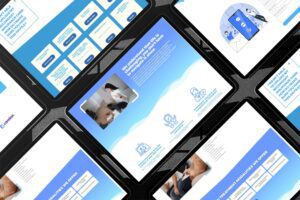In recent years, remote work has become increasingly popular, and it is now more common for people to work from home or anywhere in the world. Working for companies in other countries is easier and more accessible than ever. While this newfound flexibility brings many benefits, it also requires adapting traditional work processes to ensure seamless collaboration. Meetings, updates, feedback, and chats are just a few examples of activities that have undergone significant transformations.
Consequently, team managers have to rethink how they work with their colleagues, how they follow up, and of course, how to manage performance in remote teams. If you’re not yet entirely confident about tracking remote teams, here are some ideas you can follow.
PLANNING AND GOAL-SETTING
It’s essential to keep objectives clear, which requires excellent planning. Assuming that goals will be achieved on their own is a fantasy. The team’s first step should involve a collaborative discussion on how to approach challenges and objectives. Utilizing morning meetings or daily check-ins can gather valuable insights from colleagues, enabling progress tracking towards their goals. During a morning meeting or daily check-in, each team member should discuss 3 to 5 objectives that align with the company’s goals. When reviewing daily objectives and goals, it’s advisable to consider deadlines and prioritize activities throughout the day. Establishing times when participants are most active is also advantageous, as you can call someone if necessary. Communication plays a crucial role not only in planning but also in every step of performance management.
KPIS AND METRICS FOR PERFORMANCE TRACKING
Performance tracking stands as one of the most crucial yet complex aspects of managing remote teams. In remote work setups, the focus often revolves around completed objectives, such as the number of tasks accomplished within a given week. While time serves as a useful reference point, it’s important to acknowledge that task durations can vary. Clear communication becomes paramount in establishing these Key Performance Indicators (KPIs) and should be among the initial priorities when embarking on a project. Without clearly defined KPIs, the evaluation process lacks the necessary evidence to compare and assess performance effectively.
FOLLOW-UP AND FEEDBACK
Effective follow-up and feedback are vital components of managing performance in remote teams. While remote work offers autonomy, it is crucial to ensure tasks are completed accurately to achieve collective success. Striking a balance is essential, avoiding excessive monitoring that can erode trust. Scheduling follow-ups 2 or 3 times a week, tailored to each individual, allows for oversight without stifling autonomy. Equally important, feedback plays a pivotal role in guiding employees to improve, highlighting areas needing attention, and reinforcing strengths. By fostering a communicative culture and providing timely, constructive feedback, remote teams can thrive and continuously enhance their performance.
ENSURE A HEALTHY WORKLOAD
Ensuring a healthy workload is crucial for managing performance. To achieve this, clear communication and realistic expectations are key. Team leaders should collaborate with team members to establish manageable workloads, taking into account individual capabilities and available resources. Prioritization and time management strategies can help maintain a balanced workload. Regular check-ins and open dialogue allow for adjustments and proactive support when needed. By promoting a healthy workload, remote teams can optimize productivity, maintain well-being, and achieve sustainable performance.
DEVELOPMENT AND IMPROVEMENT OF SKILLS AND COMPETENCIES
Remote work presents unique opportunities for self-directed learning and professional advancement. Encouraging team members to engage in relevant training programs, webinars, and online courses can broaden their skill sets and knowledge base. Regular skill assessments and performance evaluations help identify areas for improvement and enable targeted development plans. By prioritizing skill enhancement and creating a culture of continuous learning, remote teams can thrive and adapt to the evolving demands of their roles. .
180º AND 360º EVALUATIONS
A 180º evaluation involves obtaining feedback from superiors, peers, and subordinates, allowing for a comprehensive view of an individual’s performance. On the other hand, a 360º evaluation expands the feedback loop to include self-assessment, enabling a holistic assessment of strengths and areas for improvement. These evaluations promote transparency, accountability, and constructive feedback within the team. By incorporating 180º and 360º evaluations into performance management practices, remote teams can foster continuous improvement, enhance collaboration, and drive overall team success.
TOOLS
The advantage of modernity is that today there are many tools available to support performance measurement in a remote team. Generally, performance management software allows you to collect real-time feedback, improve communication with your team, and enable human resources managers to analyze feedback and data to adapt personal performance improvement plans for each employee. The data collected by performance review software allows companies to identify weak points and offers the opportunity to correct course and improve. Digital workflow tools like Asana, Teams, and Scribe help you streamline processes, optimize onboarding time, and communicate efficiently across the globe.
KEY TAKEAWAYS
Managing performance in remote teams presents unique challenges and opportunities in today’s dynamic work landscape. As the popularity of remote work continues to rise, it is crucial for organizations to adopt effective strategies and practices to ensure optimal performance and productivity. Key Takeaways:
- Clear communication and goal setting are essential for managing performance in remote teams.
- Technology tools like Asana, Teams, and Scribe can streamline workflows and enhance collaboration.
- Regular follow-ups and feedback support individual growth and foster a culture of continuous improvement.
- Prioritizing a healthy workload ensures sustainable productivity and well-being.
- Emphasizing skill enhancement and learning opportunities contributes to the development of high-performing remote teams.
With effective performance management strategies in place, remote teams can thrive, achieve outstanding results, and drive organizational success in the ever-evolving landscape of remote work.


